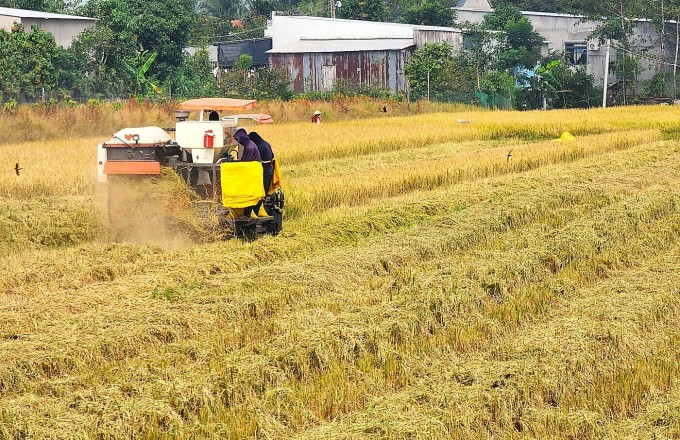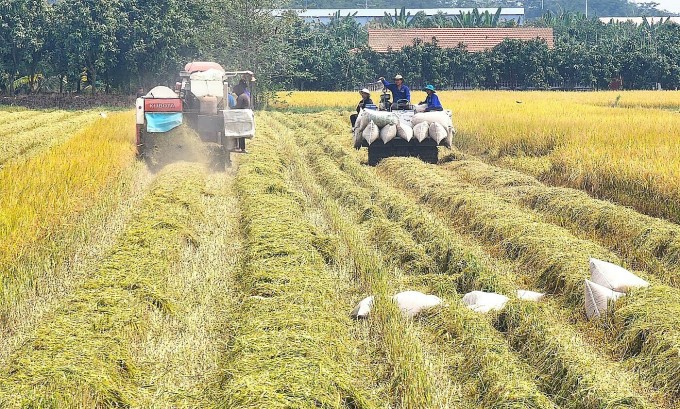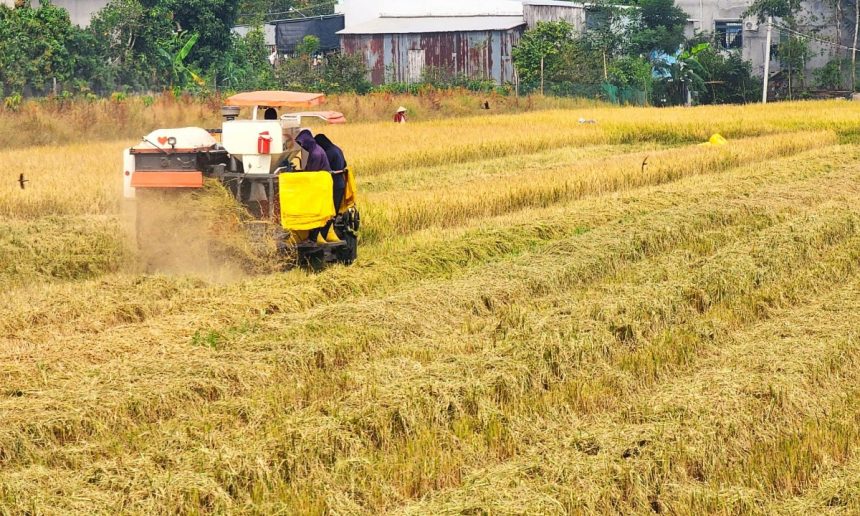Farmers in the Western provinces are harvesting Winter-Spring rice, but prices have dropped sharply and productivity is low, causing income to decrease, while Tet is near.
Mr. Man, in Tan Nghia commune, Cao Lanh district, Dong Thap province, is harvesting 7,000 m2 of rice, OM 18 variety. A month ago, he accepted a deposit to sell rice to traders, priced at 8,800 VND per kg, until the day the price was cut. Unfortunately, traders only agreed to buy for 6,700 VND.
Not only Mr. Man, many nearby field owners are in a dilemma. If they don’t sell, it will be difficult for them to find another farmer. “They deposit 300,000 VND per worker. If they remove the deposit, they won’t lose much,” Mr. Man said, saying that in this crop, the family’s rice yield is about 7 tons per hectare, after deducting costs, the profit is 2-2. 2.5 million VND per job.

Mr. Man’s field is harvesting Winter-Spring rice. Image: Ngoc Tai
According to Mr. Man, in the neighboring fields, many field owners do not accept deposits even if the price is only 6,300 VND per kilogram. This is also the lowest price in the past two years, down more than 30-40% compared to the time when rice prices were highest.
Nearby, Mr. Le Van Viet is harvesting 5,000 m2 of rice, yielding about 7 tons per hectare, 1-2 tons lower than previous years’ Winter-Spring crop. The owner of this field also reduced the selling price to 6,700 VND per kg, compared to the final price of 8,000 VND when making a sales contract with traders.
Mr. Viet said that this season production costs increased more than the same period last year due to fertilizer price increases of 10-20% and many epidemics. Accordingly, in previous years, the Winter-Spring crop only sprayed 7 times, this year increased to 9 times, this year onion mosquitoes have bitten and destroyed a lot of rice.
“Compared to two years ago, the profit is only half, or about 2 million per worker. The profit is only enough to last until the next rice crop is harvested, there is no surplus. This Tet must be spent in moderation,” Mr. Viet said.

Rice production costs have increased over the years while prices have decreased and productivity is not high, causing farmers to not make much profit. Image: Ngoc Tai
According to statistics from the Department of Agriculture and Rural Development of Dong Thap province, in the Winter-Spring crop, the whole province sowed 173,000 hectares, and nearly 1,000 hectares were harvested with a yield of about 7.2 tons per hectare. Similar to the rice fields in An Giang, Kien Giang is also in harvest season in a situation where rice prices have dropped sharply.
The Vietnam Food Association said export rice prices have dropped sharply in the past two weeks. In particular, 5% broken rice decreased to 25 USD, to only 473 USD per ton, the lowest level in the past two years.
Not only Vietnam, Thailand’s 5% broken rice also dropped to 498 USD per ton, while Pakistani rice dropped to 450 USD per ton.
Mr. Nguyen Van Don, Chairman of the Board of Directors of Viet Hung Co., Ltd., said that rice prices have dropped sharply recently partly because partners stopped buying. In particular, the Philippines stopped buying due to the New Year holiday, other countries such as Indonesia and China also stopped buying when they saw prices trending down.
In addition, India – the world’s largest rice exporter – has lifted the ban on exporting regular white rice, so the rice supply is abundant, and prices will normally return to the same as before. “In the near future, countries will also have to import rice, the price will increase again but not as feverishly as in previous years,” Mr. Don predicted.
Meanwhile, some other rice exporters said that because the price of rice from Vietnam and other countries is decreasing, importers are also hesitant and waiting to sign contracts. On the other hand, the Western provinces are entering the Winter-Spring rice harvest, so the supply is abundant, while the domestic market’s purchasing power is slow because businesses have finished preparing supplies for Tet.
Ngoc Tai



